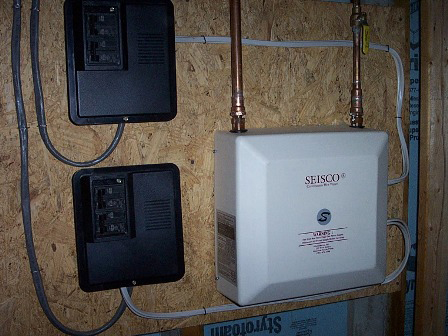Three electric hot water heater options for your renovation
Did you know hot water heating is one of the largest energy demands in a typical American home? It’s usually second after heating & air conditioning, making up 15-20% of total annual energy use.
Savings with your current tank
As is typical in most energy-saving situations, the most cost-effective way to save energy in your hot water system is to simply use less hot water. Choose ENERGY STAR clothes washers and dishwashers for their reduced hot water demand. And, check out the new EPA WaterSense label for faucets and shower heads. It took Uncle Sam two years of research to find shower heads that deliver a great shower in addition to using a bit less water. Adding an insulating hot water heater blanket and insulating your hot water lines are also cost-effective steps, especially if you have an older tank heater with less insulation than the current standard.
New options for your renovation
Now on to the three types of heaters. There used to be one option: an ordinary tank hot water heater. Those are still around (somewhat improved) but there are new, more efficient options.
Good Old Tank, with some recent changes
Tanks store many gallons of hot water, which is useful because an electric tank can’t heat up as fast as you can use hot water. It needs to keep hot water stored at the ready, so you and your teenager can both take a shower in the same 15 minute period. (Or is it a 35 minute period for your teenager…?) Then the heating can be spread out over a few hours.
For example, our wintertime water temperature in the Washington, DC area can be around 45 degrees. It takes an electric tank just over 2-1/2 minutes to heat up a gallon of water from 45 to 120 degrees. So, if your shower uses more than 1 gallon of hot water every 2-1/2 minutes (it does, even with low-flow heads), the stored hot water is needed to keep up.
There have been some minor changes to these ordinary tanks over the last few years. Mainly they now have more insulation than in past years, reducing the amount of heat leaking out through the tank walls. Look for the better tanks, with an Energy Factor (EF) over .93, meaning 93% of the electric power remains in the hot water, with only 7% escaping through the insulation.
Conventional tanks are made of steel with a glass coating on it to protect it. While the glass coating isn’t perfect, an anode rod is used to slow corrosion to a very low rate, so an electric tank will typically last 15 years or so.
Another recent innovation comes from Rheem who invented the “Marathon”, a tank heater made entirely of plastic. The tank itself can’t corrode, which is quite an improvement! Personally I’ll be a lot more confident in their durability once they’ve been in wide use for a couple of decades, but these are probably a decent option. They make particular sense if your renovation is in an area with aggressive well water, such as Loudoun county or Great Falls, Virginia.
Instantaneous, “tankless” electric heaters
It takes a crazy huge amount of electricity to instantly heat the entire amount of hot water you need for a couple of showers at the same time. You practically have to plan the entire house’s electrical service and wiring to feed enough power to an instantaneous electric hot water heater.
It can be done. I’ve seen a tankless electric heater installed in an experimental home being built by the NAHB Research Center in Bowie, MD. (The four, 240-volt circuits were very impressive.)
Obviously, there are low “standby” losses since there is no hot tank losing energy all the time. But, because few homes have enough extra electrical power to run them, tankless electric heaters are not usually a practical option for a renovation, and the next option is more efficient anyway.
Heat Pump hot water heaters
These are the new kids on the block: an electric tank heater, made much more efficient.
Generally speaking, a heat pump moves heat from one place to another. For example, the heat pump in your refrigerator moves heat from inside the box to outside the box.
A heat pump water heater moves heat from the air in the room around the tank, into the water inside the tank. This uses about half as much electricity as making heat directly like a conventional tank, yielding an Energy Factor of 2.0 or higher.
Of course, a heat pump hot water heater is more expensive than a conventional tank, but as the ENERGY STAR program says: “ENERGY STAR qualified heat pump water heaters can save the average household almost $300 per year on its electric bills compared to a standard electric water heater…Larger families — that typically use more hot water — will save even more!” One nice aspect of a heat pump heater is the ease of changing over to use one. It fits in the same place and behaves like your old tank, just using less electricity.
You may have seen the fun monkey-hot-tub ad that GE made for their Geospring heat pump hot water heater (Energy Factor: 2.3!).
Other options
There are other ways to make hot water in an electric house, which deserve consideration: if you are considering geothermal heating, one additional plus is “free” hot water all summer. Solar hot water also makes sense despite the high initial price, since it uses less than half the electricity of a conventional tank on an annual basis.
We’ll cover those in other posts!
OTHER POSTS
